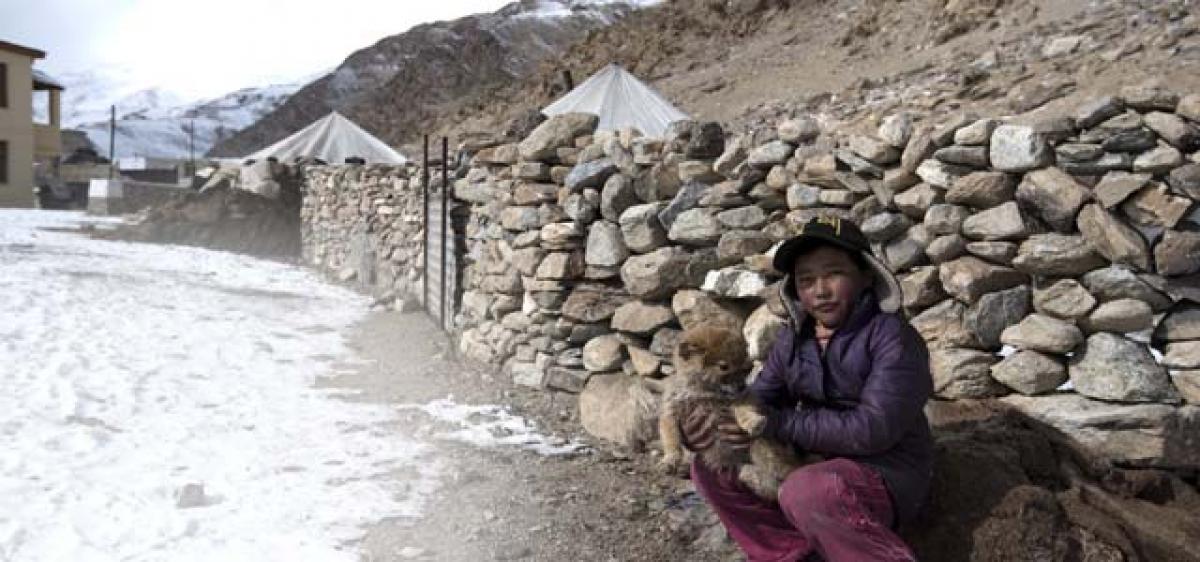Live
- Ray, Nayak fighting for 4th term MLA in Rourkela
- New Delhi: Hockey star Dilip Tirkey aims at scoring winning goal
- IndiGo, Archer to launch electric air taxis in India
- Markets snap 4-day losing streak, up on value buying
- IMF praises India’s fiscal discipline in election year
- Srikakulam: YSRCP, TDP candidates continue to face rebel trouble
- Murder sparks protests; BJP targets Cong govt
- Visakhapatnam: Bheemili MLA denies ‘baseless’ rumours about his candidature
- Cong corporator slams CM, says gang behind daughter’s murder
- Visakhapatnam: 19th Day of ‘Memantha Siddham’ at Godicherla
Just In

Snow crunched under my heavy boots as I stepped out of the heated SUV, into the freezing winter of Ladakh. It was -16 degrees and we had just arrived in Puga, a little nomadic village in the Changthang valley.
Located in the Eastern Ladakh region of Jammu and Kashmir is Puga, a geothermal field and a site for the nomads of Changthang to settle down for the winter and tend to their animals in the subzero Himalayan temperatures in this scenic land
Snow crunched under my heavy boots as I stepped out of the heated SUV, into the freezing winter of Ladakh. It was -16 degrees and we had just arrived in Puga, a little nomadic village in the Changthang valley.
Identified to be one of the important geothermal sites in India by the Geological Survey of India, Puga is a 12-kilometre stretch of Himalayan valley in the Changthang Wildlife Sanctuary. A harsh and unpredictable land interspersed with geysers and hot springs, come winter it is blanketed in snow.
Puga serves as the winter home to Changpas, Tibetan Nomads, who follow the same migratory routes in Ladakh every year, only to settle in Puga for the four cold months. Living in the same encampments, these Nomadic Pastoralists bring their livestock to the same seasonal pastures every year.
This is where we decided to stop for lunch, setting up kitchen in one of the stone walled corrals. By the time we had warmed ourselves with some Kashmiri Qawah, we were surrounded with curious eyes and runny noses. Little nomads were every where, shy but interested in the newcomers all bundled up in their down jackets.
“That’s my dog, see he is a nomad dog,” said Tenzin, in hesitant but clear English, perceptive to the point that she knows that we regular people would find anything ‘nomadic’ fascinating. Hanle, which is 115 kilometres from Puga was where she went to school but Sumdho was the closest town.
We had passed by it on our way here so I naturally assumed this is where these little nomads who spoke such good English would go to school. But only in conversing with her did I realise just how far across the Himalayas the Changpas traversed for livelihood.
The Changpas rear yaks, horses, sheep and also of course the famous ‘pashmina’ goats and the geothermal ice fields of Puga served them well as winter pastures. Winters are important for the Changpas. January and February are the birthing months andthis is also when the pashmina fur grows.
Besides it is the snow and its melt that brings greenery to this high altitude cold desert. The Changthang Wildlife Sanctuary is spread across India and Tibet and historically the Changpas of Ladakh would migrate with their herds into Tibet. But with how things arepoliticallytoday, this is no longer an option for them.
About 1,600 kilometres from Delhi, and 700 kilometers from Srinagar, this is a must visit village for those looking to explore the little known side of a much exploited tourist spot.

© 2024 Hyderabad Media House Limited/The Hans India. All rights reserved. Powered by hocalwire.com







